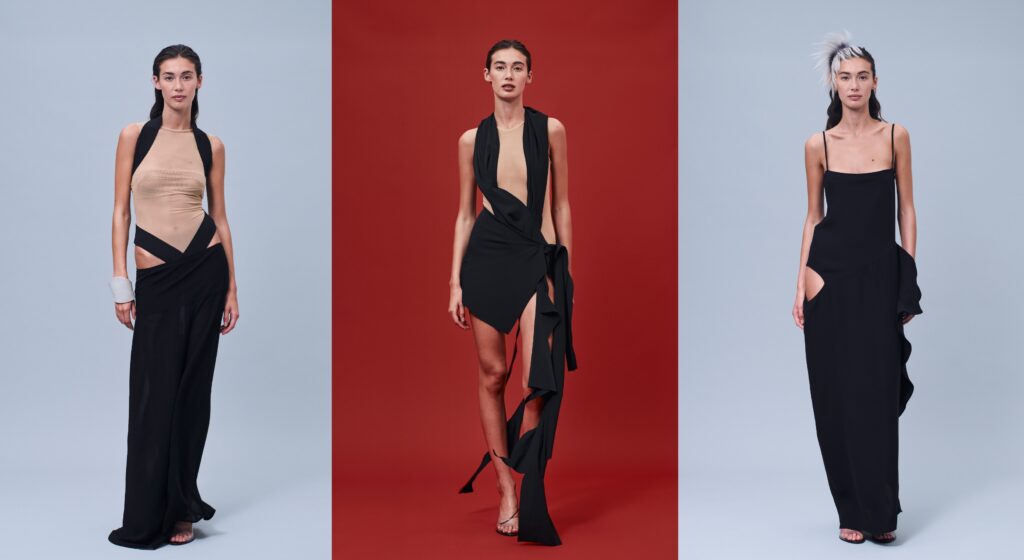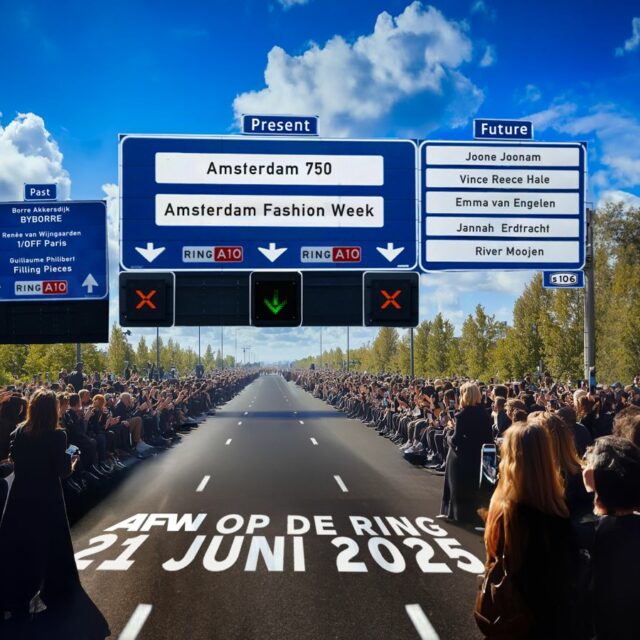Having built a successful international design career, designer Max Zara Sterck returns to her home base. For the first time, her sculptural pieces and seamless designs make an appearance on the Amsterdam Fashion Week Edition schedule and are woven into a performance that celebrates female power and sensuality in freedom. We sat down with the designer to talk about her career path, from where she started up until the preparations for her first show in Amsterdam.
Operating between London and Amsterdam, your designer debut was during London Fashion Week. Is there a reason why you’ve focused on making name internationally before showcasing in Amsterdam?
The reason I chose to debut in England is because I was living there during the first years of my career, and subsequently also set up my own business from there. I found that in England, there’s a big support system for emerging designers. The British fashion council was very invested in me as a designer and had offered me a platform at London Fashion Week. I was the opening act that year, which felt like a dream come true. Later on, they ensured that I could show my collection during Paris Fashion Week in a showroom in Paris, which is where I opened my first point of sale. Starting out abroad was therefore a natural path for me, and one I’m very grateful for.
Having never showed your collections in The Netherlands before, do you feel more pressure to showcase your work here?
Fast forward to a year ago, I moved back to the Netherlands. I never really felt connected to the Netherlands, not personally but also not in terms of my design identity. I had the feeling that many Dutch people would find my designs too sensual or too feminine. I realised however that the clash between my designs and the Dutch mindset is something I want to tackle. I want to try and close that gap between the two. I think it’s great that in the Netherlands, the mindset that everything needs to be functional and practical is dominant. The funny thing is that those concepts have subconsciously been part of my design process all this time. Suddenly I could see that I do carry some of these traits over to my designs, which are very comfortable, have pockets, and other functions to ensure practicality. The next step forward is to convince Dutch women that you can feel comfortable, sensual and strong at the same time. The sensuality that my designs hold in turn stands for the innovation that I want to bring to the table here. For this reason, it actually feels like a very nice thing to focus on The Netherlands now. To answer your question, I don’t necessarily feel more pressure. My main emotion is excitement.
I am fascinated how the identity of your designs is so clearly intertwined with your strong need to move freely in whatever you cover your body with. Can you tell me something about how your design process ensures freedom of movement?
I always work with a live model. My design process is very three-dimensional. I choose fabrics that I like and I wrap them around my model, she then walks and dances through the space and which allows me to see shapes emerge. My next step is to make a garment out of those shapes. The resulting prototypes are tried on a hundred times to see if it nurtures freedom of movement. I also think it’s important that my clothes are tried on by different people.

To come back to this need for freedom of movement, where do you think this comes from? Why is it such a big theme within your brand?
I think that has to do with the fact that I was a professional gymnast. At one point, I had to stop practicing because of an injury and that made me very limited in my freedom of movement. In addition, I had become so used to wearing that tight leotard that I want to favour the comfortability that I had in those leotards in everything. Lastly, I think that need for freedom of movement also stems from being a woman, and wanting to be able to move and exist freely. I still feel a lot of limitations in this area and I think a lot of other women do too.
What’s the biggest lesson you’ve learnt since graduating from ArtEZ in 2015?
During my studies I did everything: colours, textiles, shapes; I would make every piece of clothing really bombastic. In my graduation I found a focus, which became movement. Then I noticed that where I used to want everything, I now had the capacity to focus better which led me to my unique approach to silhouettes and shapes. Of course, during graduation you are not necessarily concerned with the idea that the piece must also be sold, or that it must be wearable and that it has to look good hanging in a store. Gaining experience at luxury houses like La Perla, JW Anderson and Alexander McQueen taught me a lot about these things. I especially learnt a lot about construction, making a garment wearable and comfortable is so important. In my case, perhaps the most important and thus I pay great attention to this. This capability of having a well-considered way of constructing a garment is the biggest lesson I have learned since graduating.
Can you tell me something about the theme of the collection you will be showing during AFW Edition 2023? Where did you draw inspiration from?
For this collection, I wanted to work with contrasts; masculine vs. feminine, flow vs. rigid, black vs. white. The concept stems from my brand logo, which is composed by the symbols + – = \. In math, this formula + and – equals –. –, or negative, predominates here. We as humans always think positive is ‘good’ and negative is ‘bad’, I want to show that our negative side holds beauty too. With this show, I want to emphasise that everyone experiences the positive and the negative and that the combination of both makes us whole and beautiful. This is an invitation to express yourself fully. The last symbol of my logo, backslash, represents the outcome of combining the two, which is the silhouette all my designs are based on

© Cover image
Photographer: Amanda Elise K





